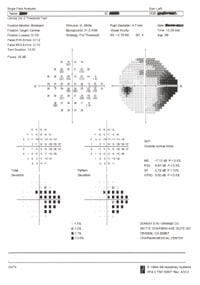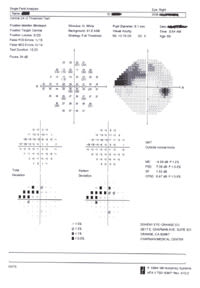Glaucoma
Case Studies
Treating with Selective Laser Trabeculoplasty
BY BRIAN A. FRANCIS, M.D.
Case History/Presentation: We were following a 70-year-old Caucasian female with a 5-year history of medically controlled primary open angle glaucoma. Previously, her IOP target had been set between 14 and 16 mm Hg. She was taking brinzolamide 1% (Azopt) b.i.d. OU, timolol maleate 0.5% (Timoptic-XE) q am OU, and latanoprost 0.005% (Xalatan) q hs OU. Her medications had been started on a strict step-wise regimen, based on the Collaborative Initial Glaucoma Treatment Study (CIGTS) protocol, to ensure that each was effective.
Her only eye complaints were a mild foreign body sensation, irritation and redness. She hadn't had any prior eye surgery, including laser trabeculoplasty. Her past medical history was unremarkable, and she was in good health.
|
|
|
|
Humphrey visual fields at the time of treatment show a superior arcuate scotoma OD and a superior arcuate and inferior nasal step OS. The visual field has remained stable over the 1-year period following SLT. |
|
Examination: Visual acuity was 20/30 OU; her IOPs were 14 OD and 13 OS. The anterior segment exam showed mild conjunctival hyperemia and punctate epithelial keratopathy. Angles were open 4+ to the ciliary body, and the lenses had 2+ nuclear sclerosis. Her optic nerves had a cup to disc ratio of 0.8. Her visual fields showed a superior arcuate scotoma in the right eye and a superior arcuate and inferior nasal step in the left eye (see visual fields, below).
Treatment: After a discussion of the risks and benefits concerning laser surgery vs. multiple medications, the patient decided to have selective laser trabeculoplasty (SLT) because of sensitivity to multiple topical medications and possible exacerbation of dry eye.
She underwent SLT in both eyes at the same visit. I used a power setting of 0.8 to 0.9 mJ and delivered about 75 spots, covering 270° of the angle.
Postoperative IOPs were as follows:
- 1 hour: 8 OD, 15 OS
- 1 day: 9 OD, 10 OS
- 1 week: 7 OD, 12 OS
- 1 month: 10 OD, 12 OS (brinzolamide discontinued)
- 3 months: 11 OD, 10 OS. (timolol maleate dis continued)
- 6 months: 13 OD, 14 OS
- 12 months: 13 OU on latanoprost alone.
Discussion: This case illustrates several points regarding selective laser trabeculoplasty:
How treatment is applied. SLT is different from argon laser trabeculoplasty (ALT) in several respects. The laser is a frequency doubled Nd:YAG with a wavelength of 532 nm; the power level is titratable from 0.4 to 2.0 mJ. The spot size -- 400 microns -- is large enough to cover the entire trabecular meshwork. (One hundred confluent spots will cover the entire 360°of the angle.) Because the pulse duration (3 nanoseconds) is shorter than the thermal relaxation time of the trabecular tissue, its effects are confined to the target tissue. This effectively eliminates the kind of thermal damage seen with ALT (Latina; Noecker).
Mechanism of effect. The leading theory, popularized by Alvarado, is that melanin-containing cells in the trabecular meshwork are stimulated to release cytokines, which in turn activate macrophages that remove debris from the intertrabecular spaces. This may explain why it takes up to 3 months for the full effect to be seen, and why SLT can be repeated if the effect eventually wears off. (Further treatment is only recommended if the initial treatment is effective.)
Safety. Several studies have shown that SLT is very safe. An IOP spike of 10 mm Hg has been observed in a maximum of 5% of patients (Latina, 1988; Damji, 2003; Francis, 2003). IOP is successfully lowered in 70% to 75% of patients, with a mean pressure reduction of 18% to 25%. With this safety profile, many glaucoma specialists recommend initially treating 270° to 360° of the angle.
Because of this level of safety, we now offer SLT even when patients' IOPs have been successfully controlled by medications, and sometimes as a first-line treatment. (SLT's efficacy as a primary treatment is being studied in an ongoing clinical trial [SLT/MED].)
Reduction of medications. Our patient was able to maintain IOP control at target with a 67% reduction in medications. However, it's worth noting that in this situation the best way to reduce medications is still unclear. As per the protocol followed in our study, we reduced medications only after the 1-month visit because the patient was below target IOP. However, study data has shown that the reduction in IOP is greater if medications are washed out before SLT, with IOP at an untreated baseline. (Whether this increases the efficacy of the laser is unknown.)
Although SLT may not be appropriate for all glaucoma patients, it's an effective addition to our armamentarium.
Dr. Francis is assistant professor of ophthalmology on the glaucoma service at the Doheny Eye Institute, Keck School of Medicine, University of Southern California.










